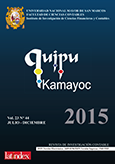SCIENTIFIC RESEARCH AT THE PUBLIC PERUVIAN UNIVERSITY AND ITS RELATIONSHIP WITH THE GOVERNMENT AND COMPANY
DOI:
https://doi.org/10.15381/quipu.v23i44.11632Keywords:
Scientific Research, University, Government, Company, technological developmentAbstract
It is known the great influence of the Triple Helix of the University, the Government and the Company on innovation and technological development, and the impact of this on the economic development of nations. However, in our country, this aspect is not fully recognized, with no efficient mechanisms for coordination, as it can be done by a Ministry of Science and Technology. Peru spends only 0.15% of GDP for research and technological development, while Chile spends more than three times that percentage, 0.5%. Crucial aspects for this deficiency is the lack of strategic and productive routing by the Peruvian Government; the lack of institutional recognition of the importance of innovation and technological development, the crisis of Peruvian universities, especially public ones.The conclusions here proposed are in relation to the implementation of the strategic and productive routing by the Peruvian Government, which would give effectiveness and relevance to the National System of Science, Technology and Innovation (SINACYT). Furthermore, the elevation of CONCYTEC as governing body and SINACYT as ministerial entity, creating an inter-university research subsystem to improve the efficiency and relevance of research in public universities. Fulfilling the stated conditions, may improve the coordination among University - Government - Company and increase the chances of a positive impact on national development
Downloads
Downloads
Published
Issue
Section
License
Copyright (c) 2015 Manuel Alberto Hidalgo Tupia, Christian Flores Camacho

This work is licensed under a Creative Commons Attribution-NonCommercial-ShareAlike 4.0 International License.
AUTHORS RETAIN THEIR RIGHTS:
a. Authors retain their trade mark rights and patent, and also on any process or procedure described in the article.
b. Authors retain their right to share, copy, distribute, perform and publicly communicate their article (eg, to place their article in an institutional repository or publish it in a book), with an acknowledgment of its initial publication in Quipukamayoc .
c. Authors retain theirs right to make a subsequent publication of their work, to use the article or any part thereof (eg a compilation of his papers, lecture notes, thesis, or a book), always indicating the source of publication (the originator of the work, journal, volume, number and date).





























